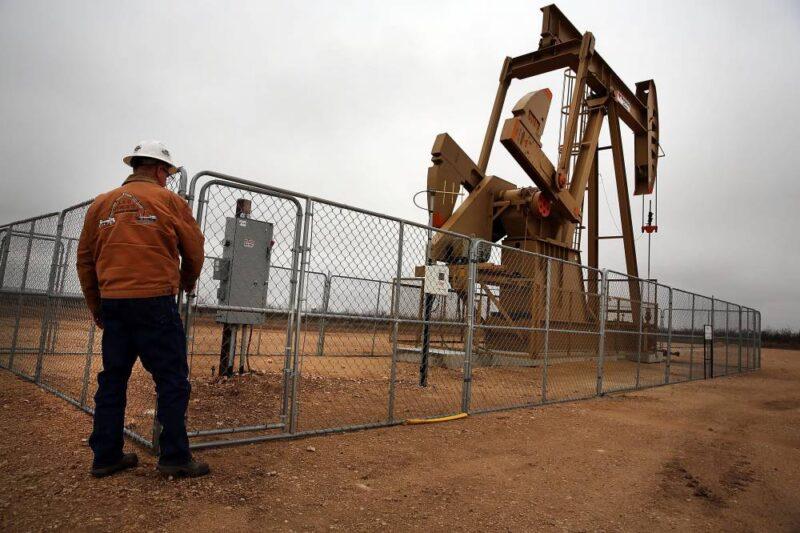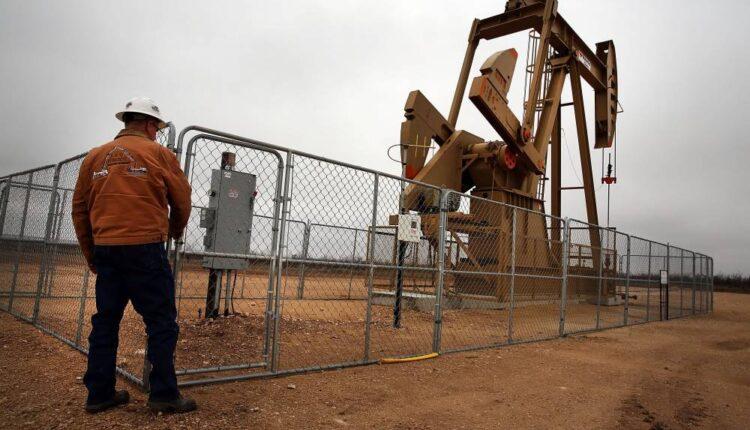US oil production plunges as the industry retrenches, and more cuts are expected after a price crash

- The U.S. oil industry reacted to cratering oil prices by cutting production by 900,000 barrels a day in just a month, in what appears to be the biggest one-month cut since the financial crisis.
- The latest weekly government data shows production of 12.2 million barrels last week, the lowest level since the week of July, 2019.
- U.S. oil production reached its all time high of 13.1 million barrels a day in February, and was last at that level in the week of March 13.
An oil well owned and operated by Apache Corporation in the Permian Basin, viewed on February 5, 2015 in Garden City, Texas.Spencer Platt | Getty Images
The U.S. oil industry reacted to cratering oil prices by cutting production by 900,000 barrels a day in just a month in what appears to be the biggest one-month decline since the financial crisis.
U.S. government data shows that U.S. production fell to 12.2 million barrels a day last week. That's off 100,000 barrels in a week, but down from a record high of 13.1 million barrels a day, just a month ago. Imports of oil into the U.S. fell to 4.9 million barrels from 5.7 million barrels a week earlier, and exports trickled off to 2.9 million barrels a day from 3.4 million.
"The U.S. oil industry is in full retrenchment, and this is just the beginning of what will likely be steep cuts," said John Kilduff, partner with Again Capital. Kilduff said the 7%, one-month decline appears to be the largest since oil production plunged 16% between August and September, 2008, when just 3.8 million barrels a day was being produced.
Oil in U.S. stockpiles rose by 15 million barrels to 518.6 million barrels. At closely watched Cushing, Okla., oil in storage rose by about 10% in a week to 59.7 million barrels, about 25 million barrels shy of its capacity.
"The market is working. It's telling producers around the world to cut production," said Andrew Lipow, president of Lipow Oil Associates. "They have to keep cutting because if you keep filling all of the oil storage and tankers, you'll just be forced to shut in because there will be no place to go."
The growth in U.S. oil production was at the heart of the dispute earlier this year between Russia and Saudi Arabia, when the world's second- and third-largest producers walked away from a more than three-year-old production pact. OPEC and Russia have since agreed to cut 9.7 million barrels a day as of May 1 in a deal that President Donald Trump helped broker. The U.S. did not officially join the pact but it was expected that U.S. production would drop off, and it now has.
There have been reports that Saudi Arabia was considering cutting sooner than May 1 because of the drop in prices, but the U.S. has moved faster to trim than OPEC and its allies just by the force of sheer economics. Producers from Texas to North Dakota are shutting in wells and curtailing plans to drill new ones.
"It shows that market forces are much more effective than oil policy that is directed from on high," said Kilduff. " Market forces are much more aggressive than national oil company policies."
Oil prices have plummeted this week with the futures and spot market turning negative. West Texas Intermediate futures for June were at $14.55 in morning trading, up 26%. The May futures contract was hit by wild trading Monday, plunging 300% as the market reacted to the lack of storage space for physical crude. Interactive Brokers said several of its clients held long position in the contracts , but were unable to cover their losses so Interactive did and took a loss provision of $88 million as a result.
The oil industry is facing the twin crisis of oversupply and a shocking lack of demand due to the economic shutdown in response to the coronavirus.
"The coronavirus just impacted everyone in a drastic manner and oil producers could not act fast enough for the demand destruction we've seen," said Lipow. For instance, U.S. drivers typically use about 10% of global oil supply each day in their cars, but the data shows gasoline demand is now at 5.3 million barrels a day, well below a more normal 9.6 million.
U.S. oil production monthly data
Source: US EIA
The U.S. production cuts so far have been dramatic and swift, and they are more than half of what some analysts have been forecasting for this year. But IHS Markit expects the U.S. production could decline by 2.9 million barrels a day from the high by year end.
"There's two worlds that are happening. The OPEC plus cuts are on an agreed upon formula, and the rest of the world is based on poor economics," said Lipow.
Analysts said the weekly data could show a lag but it is also the best real time metric the industry has. The government monthly data is processed later and adjustments are made in those numbers.
"Sometimes you have this catch up … the rig count is way down. There's a depletion rate of all these shale wells. This is a very significant decline," said Lipow.
U.S. energy exports exceeded imports last year for the first time in 67 years, including oil, natural gas, refined products and coal, according to the EIA. Oil imports fell by 31%, or 1.8 million barrels a day, from 2018 to 2019, as exports rose, averaging 2.98 million barrels a day in 2019.
Most of the U.S. imports and exports were to Canada, but U.S. oil also went to other destinations, including Europe, South Korea and China.
Source: cnbc.com

